The capital is subdivided into 8 Khans; Khan Dang Kor, Khan Meanchey, Khan Russey Keo, Khan 7 Makara, Khan Doun Penh, khan Toul Kork, Khan Chamkarmorn & Khan Sen Sok.
Area : 357 km2
Population : 1,325,681(2008)
Population Density : 4,571/km2
Tourist Attractions
Royal Palace & Silver Pagoda
 Firstly the Royal Palace was erected in the reign of King Onhea Yat (1434), and secondly it was erected in the reign King Norodom (1866). The Royal Palace was formerly called "Preah Barom Reach Veang Chatomuk Mongkul" that meant it was conveniently located at the confluence of four rivers. Nowadays it is only called "Preah Barom Reach Veang".
Firstly the Royal Palace was erected in the reign of King Onhea Yat (1434), and secondly it was erected in the reign King Norodom (1866). The Royal Palace was formerly called "Preah Barom Reach Veang Chatomuk Mongkul" that meant it was conveniently located at the confluence of four rivers. Nowadays it is only called "Preah Barom Reach Veang".
The Royal Palace is a royal residence now where his majesty, the king of Cambodia, and the royal families live. In a common word, it is like a small town of royal dynasties.
National Museum
 National Museum Designed by the French George Groslier and “Ecole des Arts Cambodgients” it was built in 1917 in the reign of King Sisowath in traditional Khmer style. The National Museum houses the world’s important collection of ancient Khmer archeological, religious, and artistic from the 4th to the 13th centuries. There are over 5000 pieces are on display including Angkorian era statues, lingas and other artifacts.
National Museum Designed by the French George Groslier and “Ecole des Arts Cambodgients” it was built in 1917 in the reign of King Sisowath in traditional Khmer style. The National Museum houses the world’s important collection of ancient Khmer archeological, religious, and artistic from the 4th to the 13th centuries. There are over 5000 pieces are on display including Angkorian era statues, lingas and other artifacts.
Wat Phnom
 Wat Phnom is located on a hill 27 meters high in the center of Phnom Penh. The legend of founding Wat Phnom has it that in 1372 Lady Penh (Yeay Penh) fished a floating koki tree out of the river. Inside the tree were four Buddha statues. She built a hill (Phnom) and a small temple (Wat) which is now known as “Wat Phnom”. The current temple was last rebuilt in 1926 and the large stupa contains the remains of King Ponhea Yat who moved the capital from Angkor to Phnom Penh in 1422.
Wat Phnom is located on a hill 27 meters high in the center of Phnom Penh. The legend of founding Wat Phnom has it that in 1372 Lady Penh (Yeay Penh) fished a floating koki tree out of the river. Inside the tree were four Buddha statues. She built a hill (Phnom) and a small temple (Wat) which is now known as “Wat Phnom”. The current temple was last rebuilt in 1926 and the large stupa contains the remains of King Ponhea Yat who moved the capital from Angkor to Phnom Penh in 1422.
Toul Sleng Genocidal Museum (S 21)
 This was a high school prior to the Khmer Rouge regime (1975-79). The museum of Genocidal Crimes it was used by the Khmer Rouge as a detention and torture center in the late 1970 which chronicle the years under the rule of the Khmer Rouge. The building now serves as a museum, a memorial and a testament to the madness of the Khmer Rouge regime. Much has been left in the state it was in when the Khmer Rouge abandoned it in 7th January 1979. The prison kept extensive records, leaving thousands of photos of their victims, many of which are on display. Paintings of torture at the prison by Vann Nath, a survivor of Toul Sleng, are also exhibited.
This was a high school prior to the Khmer Rouge regime (1975-79). The museum of Genocidal Crimes it was used by the Khmer Rouge as a detention and torture center in the late 1970 which chronicle the years under the rule of the Khmer Rouge. The building now serves as a museum, a memorial and a testament to the madness of the Khmer Rouge regime. Much has been left in the state it was in when the Khmer Rouge abandoned it in 7th January 1979. The prison kept extensive records, leaving thousands of photos of their victims, many of which are on display. Paintings of torture at the prison by Vann Nath, a survivor of Toul Sleng, are also exhibited.
Cheung Ek Killing Fields
 The notorious Killing fields of Cheung Ek is located 15km of Phom Penh. In this place more than 17,000 civilians were killed and buried in mass graves; many of them transported here after detention and torture in Toul Sleng prison.
The notorious Killing fields of Cheung Ek is located 15km of Phom Penh. In this place more than 17,000 civilians were killed and buried in mass graves; many of them transported here after detention and torture in Toul Sleng prison.
The memorial at Cheung Ek just outside Phnom Penh was an orchard and a Chinese cemetery prior to 1975. Cheung Ek is now a group of mass graves, killing areas and a memorial stupa containing thousands of skulls and long bones.
Central Market (Phsar Thmei)
 The unique, art décor building is a Phnom Penh landmark. Prior to 1935 the area was a swamp/lake that received the runoff during the rainy season. Central market is one of the largest and business markets in Phnom Penh which is a big yellow dome. Built in 1937 by French architects many interesting products are available. Central market in Phnom Penh is a good place to purchase everything from fish and vegetable to second-hand clothes, silk scarves, silverware, gems, antiques and other commodities.
The unique, art décor building is a Phnom Penh landmark. Prior to 1935 the area was a swamp/lake that received the runoff during the rainy season. Central market is one of the largest and business markets in Phnom Penh which is a big yellow dome. Built in 1937 by French architects many interesting products are available. Central market in Phnom Penh is a good place to purchase everything from fish and vegetable to second-hand clothes, silk scarves, silverware, gems, antiques and other commodities.
Independent Monument
 The independence Monument (Vimean Ekareach) was inaugurated on 9th November 1962 to celebrate Cambodia’s independence from French rule (1863-1952). It was designed by the renowned Cambodian architect, Vann Monyvann.
The independence Monument (Vimean Ekareach) was inaugurated on 9th November 1962 to celebrate Cambodia’s independence from French rule (1863-1952). It was designed by the renowned Cambodian architect, Vann Monyvann.
The Independence Monument is today used to commemorate the souls of combatants and heroes who laid down their lives for freedom of country. It is the site of colorful celebrations and services on holidays such as Independence Day and Constitution Day.
Ounalom Monastery
 Built in 1443 to enshrine a sacred hair of the Buddha, and located north of the National Museum of Arts, this temple is considered the seat of Cambodian Buddhism. When the Khmer Rouge evacuated Phnom Penh in 1975, they vandalized the building and murdered the Abbot along with many of the 500 monks who lived there.
Built in 1443 to enshrine a sacred hair of the Buddha, and located north of the National Museum of Arts, this temple is considered the seat of Cambodian Buddhism. When the Khmer Rouge evacuated Phnom Penh in 1975, they vandalized the building and murdered the Abbot along with many of the 500 monks who lived there.
Located on the riverfront which is reputedly the oldest Buddhist foundation in the city, probably predating the abandonment of the capital at Angkor in the 15th century. The founding date is variously cited as 1422 and 1443.
National Olympic Stadium
 Construction on the National Sports Complex started in 1963 and was completed in 1964. Designer Vann Molyvann made use of massive earthworks to create the stadium, digging up 500,000 cubic meters of earth to shape the grounds.
Construction on the National Sports Complex started in 1963 and was completed in 1964. Designer Vann Molyvann made use of massive earthworks to create the stadium, digging up 500,000 cubic meters of earth to shape the grounds.
The stadium might have been built to host the 1963 Southeast Asian Peninsular Games, but the games were cancelled due to political problems in Cambodia. There was also the short-lived GANEFO games, and they were held in Phnom Penh, Cambodia in November 25th~December 6th, 1966 and were named
'First Asian GANEFO'. The stadium did play host to appearances by visiting dignitaries and state occasions, and was the home of Cambodia's national athletics teams.
The stadium played a small part in the 1966 FIFA World Cup. Unexpectedly, North Korea faced Australia in a qualifier. Because North Korea lacked dipomatic relations with most countries, finding a suitable venue for the match proved difficult, until Head of State Norodom Sihanouk, an ally of Kim Il-sung, said the matches could be held in Phnom Penh. The matches attracted 40,000 fans, with Sihounouk decreeing half would cheer for Australia, while the other half cheered the Koreans. The matches were held on 21 November 1965 and on 24 November 1965 with North Korea winning both (6–1 and 3–1). Because South Korea and all African teams had withdrawn in protests against FIFA, North Korea were thus directly qualified to the final tournament, where they reached the quarter-final.
Among the facilities are Olympic-size pools for swimming and diving and an indoor volley-ball court with a capacity of up to 8,000, now known as the Olympic Stadium Indoor Arena.
During the Khmer Rouge era, the stadium was used as the site of executions by the Khmer Rouge of officials in the administration of Lon Nol.
 Chrouy Changvar Bridge
Chrouy Changvar Bridge
Known as the Cambodia-Japan Friendship Bridge, it was first constructed in 1966. It was twice mined and destroyed by the Khmer Rouge forces in 1975. It was repaired in 1993 by Japanese funding.
Koh Dach (Silk Island)
 For those with an interest in Cambodia silks and silk weaving should go to visit a rural weaving village on Koh Dach. The weaving village is a typical rural Cambodian stilted village, dedicated almost entirely to silk weaving-people operating hand looms under most of the houses, others dying and spinning silk on spinning wheels made of bicycle parts. The boat may stop at Mekong Island (Koh Okhna Tey) and some other weaving houses along the way.
For those with an interest in Cambodia silks and silk weaving should go to visit a rural weaving village on Koh Dach. The weaving village is a typical rural Cambodian stilted village, dedicated almost entirely to silk weaving-people operating hand looms under most of the houses, others dying and spinning silk on spinning wheels made of bicycle parts. The boat may stop at Mekong Island (Koh Okhna Tey) and some other weaving houses along the way.
River Boat Cruising
 Short river cruises and sunset cruises along the Phnom Penh riverfront are offered an interesting view of the city and watching the daily life of the people living on and around the river. A cruise typically take about 1-2 hours and run up the Tonle Sap river along the central riverfront area providing a picturesque view of the Royal Palace, National Museum, parks and Phnom Penh skyline, and then across the Tonle Sap and up to the Mekong river to view floating fishing villages.
Short river cruises and sunset cruises along the Phnom Penh riverfront are offered an interesting view of the city and watching the daily life of the people living on and around the river. A cruise typically take about 1-2 hours and run up the Tonle Sap river along the central riverfront area providing a picturesque view of the Royal Palace, National Museum, parks and Phnom Penh skyline, and then across the Tonle Sap and up to the Mekong river to view floating fishing villages.
Golf Course
Phnom Penh, Cambodia's laid back capital, has 2 full scale 18-hole golf courses on its western outskirts.
 Cambodia Golf and Country Club: is located 35km west of Phnom Penh, Cambodia’s charming capital city, and was the second 18 hole golf course to open in the country in 1996. The 7,000+ yard course is in a pleasant rural setting surrounded by palm trees, native fruit trees, evergreen plants and beautiful flowers, with a sprinkling of rocks. With a backdrop of distant mountains it is a delightful location. The course is relatively challenging with a large number of bunkers to keep you alert.
Cambodia Golf and Country Club: is located 35km west of Phnom Penh, Cambodia’s charming capital city, and was the second 18 hole golf course to open in the country in 1996. The 7,000+ yard course is in a pleasant rural setting surrounded by palm trees, native fruit trees, evergreen plants and beautiful flowers, with a sprinkling of rocks. With a backdrop of distant mountains it is a delightful location. The course is relatively challenging with a large number of bunkers to keep you alert.
 Royal Cambodia Golf Club: lies 10km west of Phnom Penh, Cambodia’s charming capital city and was the first 18 hole golf club to open in the country. The 7,075 yard course is set in an attractive environment sitting amongst rice paddies and coconut palms. The course is rather flat yet it still provides a challenge with numerous sand and water hazards, including a large lake near the third hole! Being the closet course to Phnom Penh it is popular with local dignitaries, and it is said it is the Prime Minister’s preferred course - perhaps due to the fact he got a hole-in-one here in 2004!
Royal Cambodia Golf Club: lies 10km west of Phnom Penh, Cambodia’s charming capital city and was the first 18 hole golf club to open in the country. The 7,075 yard course is set in an attractive environment sitting amongst rice paddies and coconut palms. The course is rather flat yet it still provides a challenge with numerous sand and water hazards, including a large lake near the third hole! Being the closet course to Phnom Penh it is popular with local dignitaries, and it is said it is the Prime Minister’s preferred course - perhaps due to the fact he got a hole-in-one here in 2004!
Airport
 Phnom Penh International Airport is the second-largest and second-busiest airport in Cambodia. It is located 7 km (4.3 miles) west of central Phnom Penh. Taxis, pick-ups and minibuses leave Phnom Penh for destinations all over the country, but are fast losing ground to cheaper and more comfortable buses. Phnom Penh also has a rail service.
Phnom Penh International Airport is the second-largest and second-busiest airport in Cambodia. It is located 7 km (4.3 miles) west of central Phnom Penh. Taxis, pick-ups and minibuses leave Phnom Penh for destinations all over the country, but are fast losing ground to cheaper and more comfortable buses. Phnom Penh also has a rail service.
Penh is one of the very few Asian cities with virtually no traffic jams. The modern layout of Phnom Penh is a French creation. Colonial landmarks can be seen all over the capital, including the National Museum and the beautiful art-deco Central Market.
We wish all of you a pleasant stay in Phnom Penh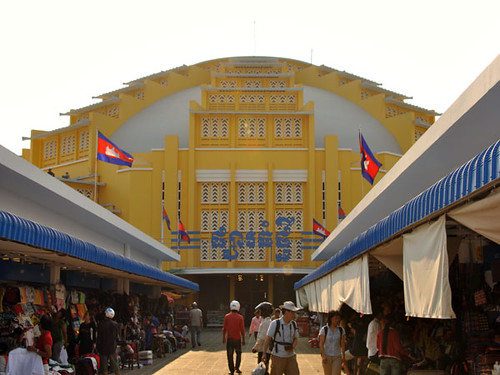

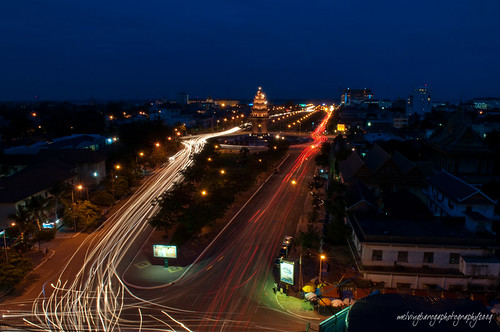


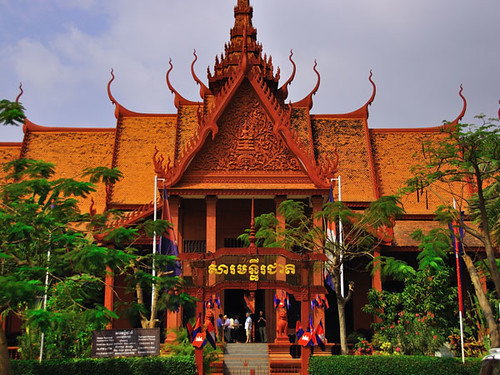

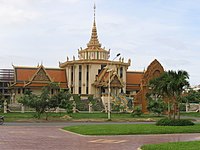
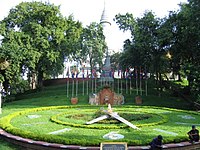


0 comments:
Post a Comment